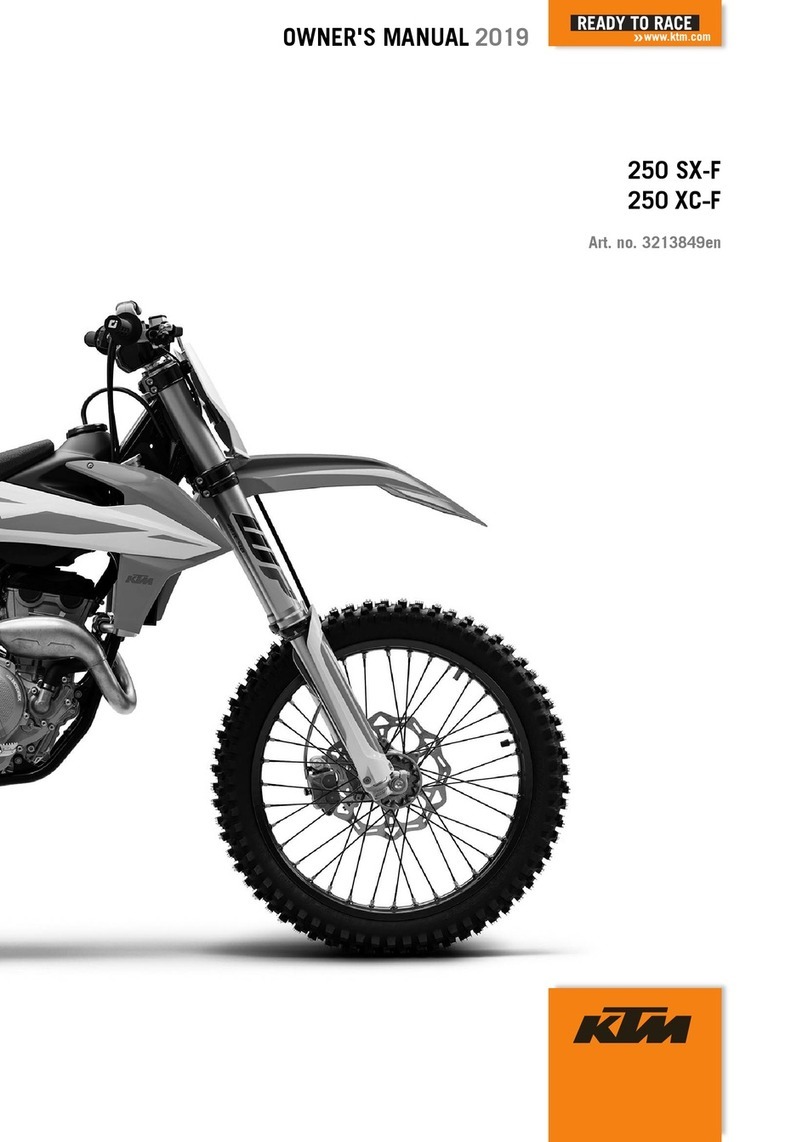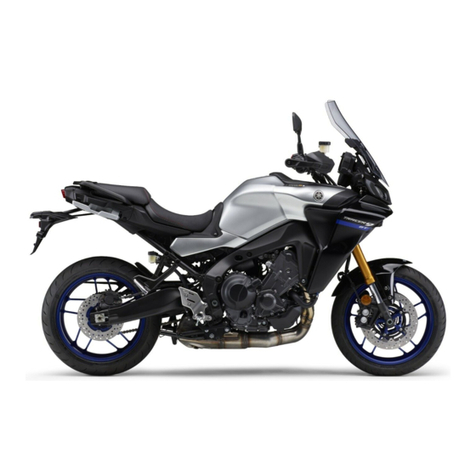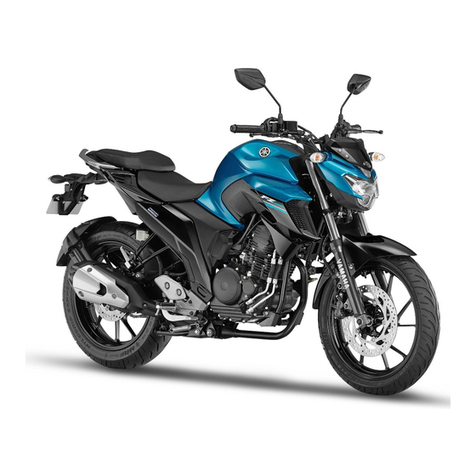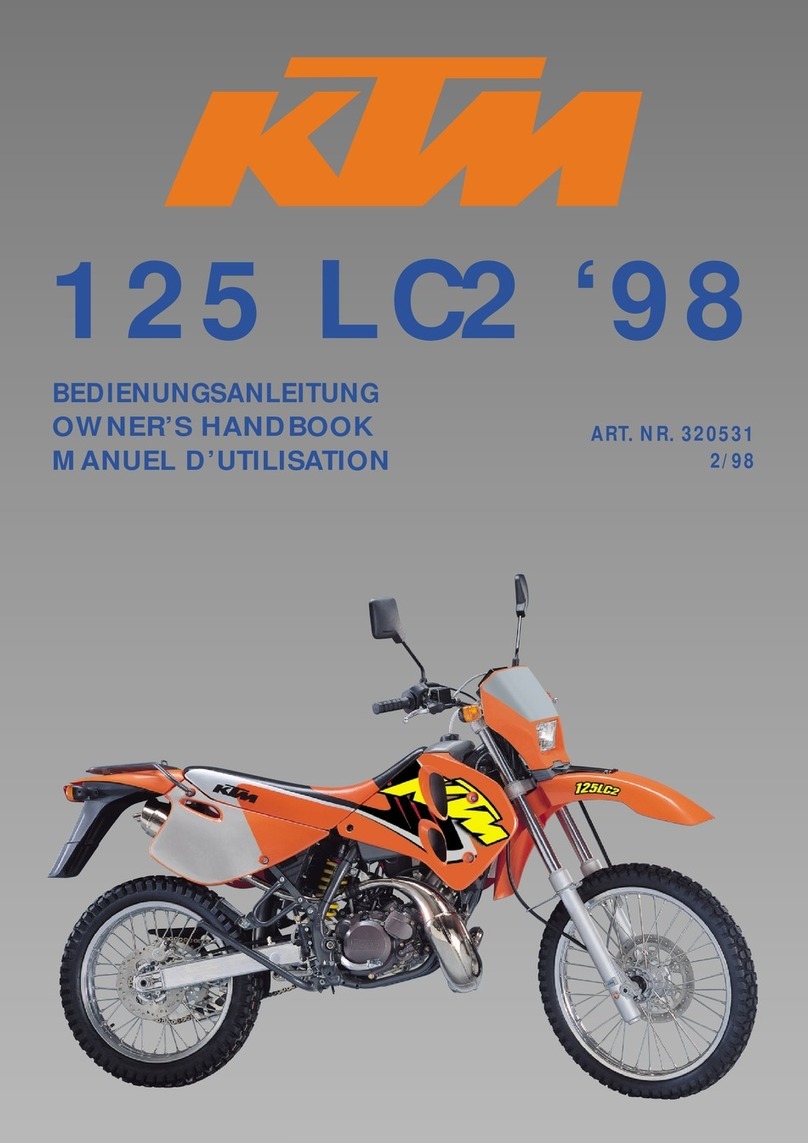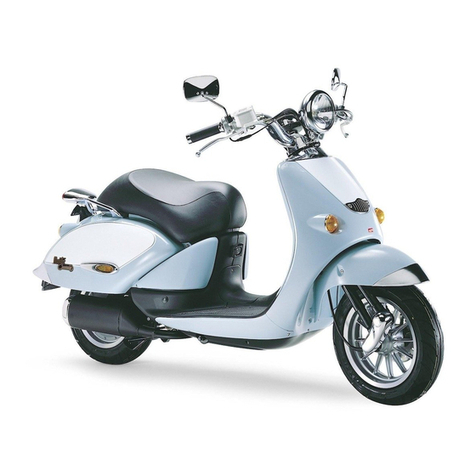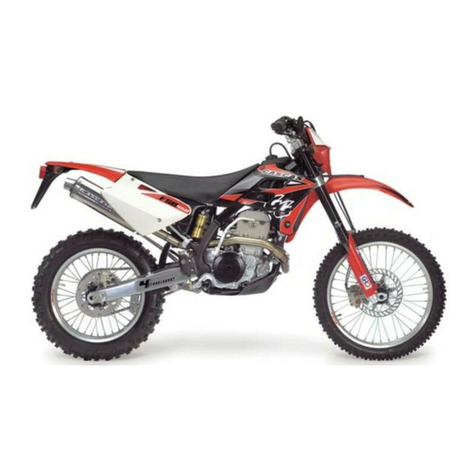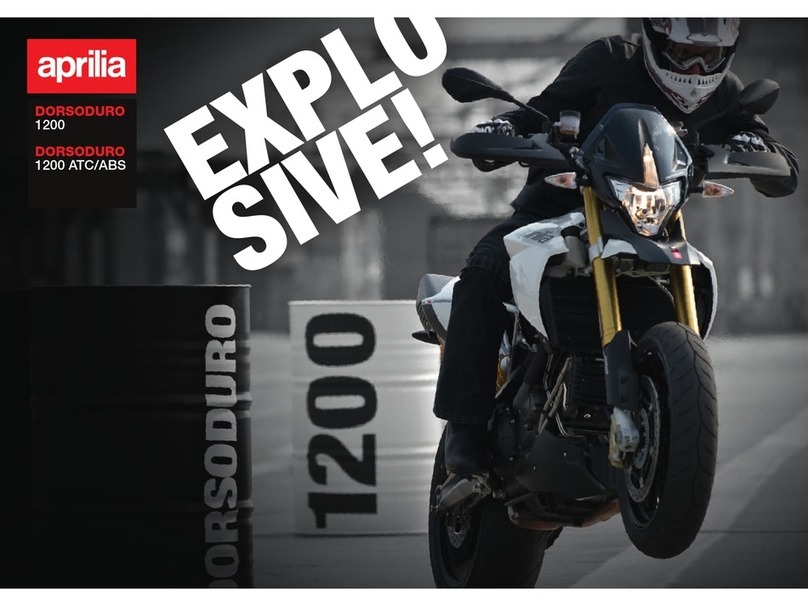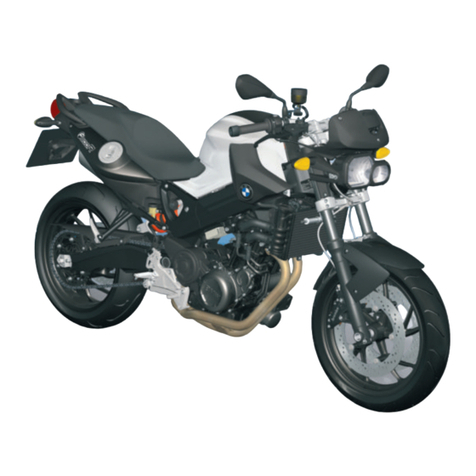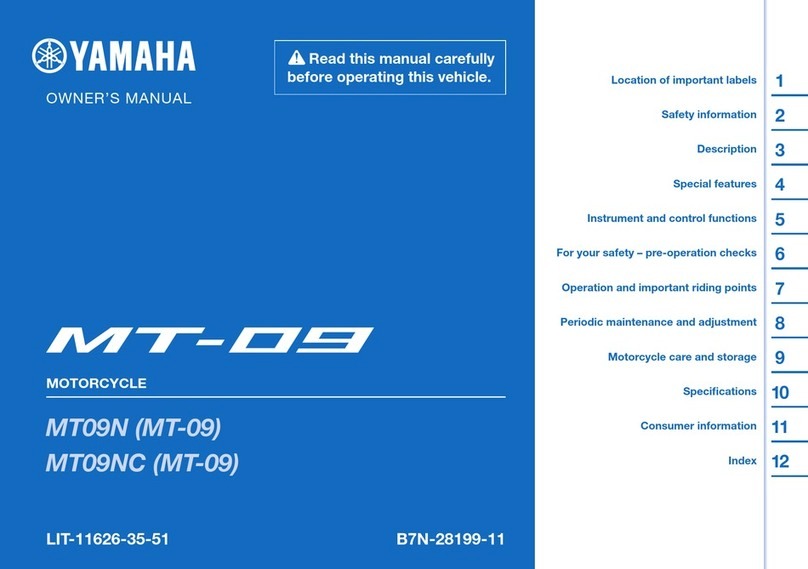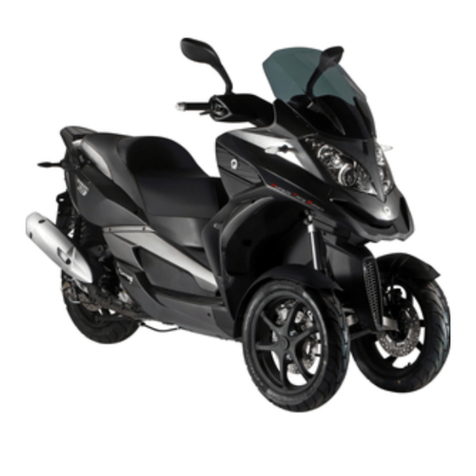TGB X-MOTION 250 User manual

DEAR USERS :
WE WOULD LIKE TO INFORM YOU THAT UNDER OUR STRICT QUALITY CONTROL
SYSTEM FOR THE PRODUCTION OF OUR SCOOTERS, WE OFFER A COMPLETE
GUARANTEE AS INDICATED IN THE GUARANTEE BOOKLET ISSUED BY OUR TGB
DEALER. OUR SCOOTER MUST UNDERGO ALL PERIODIC MAINTENANCE AND
SERVICES BESIDES, ORIGINAL SPARE PARTS MUST BE USED. IN CASE OF DEFECTS IN
STRUCTURE OR PART MATERIALS PRODUCED, ASSISTANCE IS OFFERED AT FREE OF
CHARGE UNDER VALID WARRANTY. THE ABOVE-MENTIONED GUARANTEE IS NOT
VALID UNDER THE FOLLOWING CONDITIONS:
THE DESIGNATED LUBRICATING OIL IS NOT USED.
MAINTENANCE OR REPAIR IS NOT CARRIED OUT IN THE APPROPRIATE MANNER.
UNGUARANTEED PARTS ARE UTILIZED AND MODIFICATIONS TO THE ORIGINAL
DESIGN ARE CARRIED OUT.
INSTRUCTIONS IN THE OWNER‘S MANUAL ARE NOT PROPERLY FOLLOWED.
PARTS SUBJECT TO NORMAL WEAR SUCH AS THE SEAT, SPARK PLUGS, ELECTRIC
BULBS AND CABLES.... ETC.,ARE NOT COVERED BY GUARANTEE.
THIS MANUAL IS A GUIDE FOR THE OPERATION INSPECTION AND BASIC MAINTENANCE
OF THIS SCOOTER. IF YOU HAVE ANY FURTHER QUERIES PLEASE CONTACT THE TGB
DEALER, WHO WILL BE READY TO HELP YOU OUT AT ALL TIMES.
WARNING:
PLEASE USE SAE 10W-40 API SH/CE OR SG/CC GRADE LUBRICANT OIL TO REFILL
THE ENGINE, OTHERWISE, THE ABOVE MENTIONED GUARANTEE IS NOT VALID.

1. CONTENTS
1. Contents ....................................................................................................................... 1
2. Control Location ........................................................................................................... 3
3. Before Riding ............................................................................................................... 4
4. Safe Riding .................................................................................................................... 4
5. Driving ........................................................................................................................... 5
6. Use Genuine Spare Parts ............................................................................................. 5
7. Use of Each Component ............................................................................................... 6
Gauges
.................................................................................................................…......... 6
Operation
of
Ignition
Switch
.......................................................................................…...…..8
Use
of
Buttons
...........................................................................................................….... 9
Saddle
Lock
....................................................................................................................….. 12
Storage
Box
....................................................................................................................….. 12
Pillion
Step
.....................................................................................................................…... 12
Fuel
Tank
Cap
.............................................................................................................…. 13
Frame Number
............................................................................................................….. 13
Brake
.........................................................................................................................….…14
8. Important Points and Cautions for Starting Engine .................................................… 15
9. The Best Way to Drive off ........................................................................................ 16
The
Control
of
Throttle
Valve
Handle
............................................................................… 16
Parking
Method
...........................................................................................................… 16
10. Inspection and Maintenance before Riding .............................................................… 17
Routine
Inspection
.......................................................................................................… 17
Engine
Oil
Inspection
and
Change
.................................................................................… 17
Fuel
Inspection
..........................................................................................................…. 18
Transmission
Oil
Inspection
and
Change
........................................................................… 18
Inspection
and
Adjustment
of
Brake
Free
Play
................................................................... 19
Disc
Brake
Inspection
..................................................................................................... 19
Throttle
Valve
Handle
Clearance
Adjustment
..................................................................... 20
Inspection
and
Maintenance
of
Battery
.............................................................................. 21
Tire
Inspection
............................................................................................................... 22
Steering
Handle
Front
Shock
Absorbers
Inspection
............................................................. 22
Rear
Cushion
Hardness
Setting
....................................................................................... 23
Checking
and
Changing
Fuses
......................................................................................... 23
Checking
the
Turn
Signal
Lights
and
Horn
......................................................................... 23
1

1. CONTENTS
Checking
the
Front
and
Rear
Lights
.................................................................................. 24
Checking
the
Brake
Light
................................................................................................. 24
Checking
for
Fuel
Leakage
.............................................................................................. 24
Checking
the
Lubrication
of
Body’s
Various
Mechanisms
..................................................... 24
Checking
the
Spark
Plug
................................................................................................. 24
Cooling
system
inspection
............................................................................................... 25
Replenishment
of
coolant
................................................................................................ 25
A
reference
table
for
anti-freeze
concentration
percentages
under
different
temperatures
........ 26
Crankcase
Blow-By
Ventilation
......................................................................................... 26
Checking
the
Air
Cleaner
................................................................................................. 27
Checking
The
Left
Crankcase
Cover
Air
Cleaner
................................................................ 27
11. When there is an Abnormal Condition or a Trouble .................................................... 28
Diagnosis
when
Engine
does
not
Start
.............................................................................. 28
12. C.D.I. Electrical Ignition System .................................................................................. 28
13. Suggestions on Engine Fuel ....................................................................................... 28
14. Transmission Oil ......................................................................................................... 28
15. Cautions for Riding Scooter ........................................................................................ 29
16. Periodical Maintenance Schedule ............................................................................... 30
17. Specification ................................................................................................................ 31
2

2. CONTROL LOCATION
Hazard
/
Light
/
Starter
switch
Turn
signal light
Storage box
Pass
/
High
&
Low
beam
/
Turn
signal
/
Horn
switch
Fuses.
Fuel
tank
cap
Seat
lock.
Head
light
Tail
light/
Turn
signal light
Front
brake
lever
Side
stand
Main
stand
Rear brake
lever
Coolant
filler
cap
Ignition
switch
Muffler
3

3. BEFORE RIDING
This
manual
describes
the
correct
usage
of
this
scooter
including
safety
riding,
simple
inspection
methods
and
so
on.
For
a
more
comfortable
and
safety
riding,
please
read
this
manual
carefully.
For
your
benefit,
please
ask
your
dealer
the
operating
manual
and
carefully
read
the
following:
Correct
use
of
the
scooter.
Pre-delivery
inspection
and
maintenance.
Thank
you
very
much
for
your
patronage
In
order
to
maximize
your
scooter’s
performance,
a
periodical
inspection
and
maintenance
should
be
completely
carried
out.
We
recommend
that
after
riding
your
new
scooter
for
the
first
300
kilometers,
you
should
take
your
scooter
to
the
original
dealer
for
an
initial
inspection,
and
to
have
your
scooter
inspected
periodically
every
1000
kilometers
thereafter.
In
case
the
scooter’s
specifications
and
construction
are
modified
and
different
from
the
photos
and
diagrams
on
the
owner’s
manual
/
catalogues,
the
specifications
and
construction
of
the
actual
scooter
shall
prevail.
4. SAFE RIDING
It
is
very
important
to
be
relax
and
clothe
properly
when
driving,
observe
traffic
regulations,
do
not
rush,
always
drive
carefully
and
relaxed.
Usually,
most
people
would
ride
their
newly
bought
scooter
very
carefully,
but
after
they
became
familiar
with
their
scooters,
they
tended
to
become
reckless
which
may
result
in
an
accident.
To
remind
you:
Please
wear
a
safety
helmet,
and
properly
tighten
the
chin
belt
when
riding
a
scooter.
Clothes
with
open
or
loose
cuffs
may
be
blown
by
wind
and
cause
the
cuffs
to
get
caught
on
the
steering
handle
and
thus
affects
riding
safety.
So,
put
on
clothes
with
tight
sleeves.
Hold
the
steering
handle
by
both
hands
when
riding.
Never
ride
with
only
one
hand.
Observe
the
speed
limit.
Wear
suitable
low-heel
shoes.
Perform
periodical
maintenance
and
inspection
in
accordance
with
the
schedule.
WARNING!!
To
avoid
getting
burned
by
exhaust
pipe
when
taking
a
passenger.
Make
sure
your
passenger
has
put
his/her
feet
on
the
pedals.
After
running,
the
exhaust
pipe
is
very
hot,
be
careful
not
to
get
burned
when
conducting
an
inspection
or
maintenance.
After
running,
the
exhaust
pipe
is
very
hot,
select
a
suitable
location
to
park
your
scooter
to
avoid
others
getting
burned
by
the
exhaust
pipe.
CAUTION:
Modified
scooter
will
affect
its
structure
or
performance,
and
cause
poor
engine
operation
or
exhaust
noise,
which
will
result
in
shortening
the
scooter’s
service
life.
Besides,
modification
is
illegal
and
does
not
conform
to
the
original
design
and
specifications.
A
modified
scooter
will
not
be
covered
by
warranty,
therefore,
do
not
modify
your
scooter
at
will.
4

5. DRIVING
Keep
the
related
parts
of
your
body
such
as
arms,
palms,
lumbar,
and
toes
relax
and
ride
with
the
most
comfortable
posture
in
order
to
be
able
to
react
quickly
whenever
it
is
necessary.
Rider’s
posture
will
greatly
affect
riding
safety.
Always
keep
your
body’s
gravity
in
the
center
of
the
saddle,
if
your
body’s
gravity
is
on
the
rear
part
of
saddle,
the
front
wheel
load
will
be
reduced,
and
this
will
cause
the
steering
handle
shaking.
It
is
dangerous
to
ride
a
scooter
with
an
unstable
handle.
It
will
be
much
easier
to
make
a
turn
if
rider
inclines
his
body
inward
when
turning.
On
the
other
hand,
the
rider
will
feel
unstable
if
his
body
and
the
scooter
do
not
incline.
The
scooter
is
hard
to
control
on
a
bumpy,
unleveled,
unpaved
road,
try
to
know
the
road
conditions
in
advance,
slow
down
and
use
your
shoulder’s
force
to
control
the
handle.
Suggestion:
Do
not
load
objects
on
the
front
pedals
unnecessarily,
to
avoid
affecting
the
riding
safety
and
the
operation
of
steering
handle.
CAUTION:
The
rider’s
feeling
on
the
handle
is
slightly
different
with
a
load
or
without
a
load.
Overload
may
cause
the
handle
to
swing
and
affects
the
riding
safety.
Therefore,
do
not
overload
your
scooter.
CAUTION:
Do
not
place
flammable
materials
such
as
rags
between
the
body
side
cover
and
engine
to
avoid
components
damaging
by
fire.
Do
not
load
objects
on
areas
not
specified
for
loading
to
avoid
damage.
SUGGESTION
To
maximize
the
scooter’s
performance
and
prolong
its
service
life:
The
first
month
or
first
1000km
is
the
wear-
in
period
for
the
engine
and
components.
Avoid
rapid
acceleration,
and
keep
the
speed
smoothly.
6. USE GENUINE SPARE PARTS
In
order
to
maintain
the
scooter’s
best
performance,
each
part’s
quality,
material,
and
machined
precision
must
conform
with
the
design
requirements.
“
Genuine
Spare
Parts”
were
made
from
the
same
high
quality
materials
used
for
the
original
scooter.
No
parts
would
be
sold
to
the
market
until
they
could
meet
the
designed
specifications
through
sophisticated
engineering
and
stringent
quality
control.
Therefore,
it
is
necessary
to
purchase
“
Genuine
Spare
Parts”
from
“
Authorized
Dealers
or
Franchised
Dealers”
when
replacing
spare
parts.
If
you
buy
cheap,
or
fake
substitute
parts
from
the
market,
no
guarantee
can
be
provided
either
for
the
quality
or
durability.
Also,
it
may
result
in
unexpected
troubles
and
lower
the
scooter’s
performance.
Always
use
TGB
Genuine
Spare
Parts
to
keep
your
scooters
pure
blood
and
to
ensure
its
long
service life.
5

7. USE OF EACH COMPONENT
(The
following
is
TGB
4
stroke
liquid
cooling
scooter’s
basic
operation,
and
they
could
vary
from
different
individual
models.
Please
consult
the
end
of
this
manual.)
Turn Signal Indicator
Tachometer
Total Kilometer
EFI Indicator
(250cc only)
Trip Kilometer
Speedometer Battery Charge
Alarm
Time Engine Coolant
Temperature
Fuel Indicator High Beam Indicator
Menu Button Select Button
CAUTION
:
Before
battery
installation,
please
do
not
use
the
kick
starter
to
start
the
engine,
in
prevention
Not
to
have
trouble
on
electrical
meter
working,
or
damage
the
electrical
meter.
Do
not
wipe
plastic
components,
e.g.
instrument
panel,
headlight,
with
organic
solvents
such
As
gasoline…etc.
to
avoid
damaging
these
components.
THE
BUTTON OPERATIONS
■ Digital Clock:
1. Display shows Hour:Minute.
2. Press Select Button 0.5~3sec., convert display Hour:Minute into Month:Day.
3. Display shows Month:Day>6 sec., it will back to Hour:Minute automatically.
■ Time Setting:
1. Press Select Button>3sec., convert display into time setting.
2. Setting Step:Month→Day→Hour→Minute, flashing by step.
3. Press Menu Button to adjust date and time.
4. Terminate operation>3sec., display will back to show Hour:Minute automatically.
■ Reset Trip Odometer:
1. Press Menu Button>3sec. to reset trip odometer.
2. Only trip odometer can be reset. Odometer data was stored and can’t be reset.
■ Convert km/h←→mph:
1. Press both Menu Button & Select Button>6sec., km/h & mph converted.
2. When km/h & mph converted, unit of odometer and trip odometer converted (km←→mile)
at the same time automatically.
※ All operations above are under main switch at ON position.
6

7. USE OF EACH COMPONENT
High
Beam
Indicator(
blue)
:
This
indicator
comes
on
with
high
beam
headlight
is
turned
on.
Turn
Signal
Indicator(green)
:
The
left
or
right
Indicator
will
be
flashing
according
to
the
operated
directions
of
turn
signal
light
switch
when
it
is
turned
on.
Fuel
Gauge
:
The
fuel
gauge
doesn’t
come
on
when
the
main
switch
is
at
“OFF”
position.
When
key
switch
is
turned
to
“ON”,
and
the
“pointer”
indicates
above
“E”
position,
it
shows
how
much
fuel
in
the
tank,
and
also
the
fuel
indicator
light
keeps
coming
on.
When
the
“pointer”
is
below
“E”
position,
the fuel
indicator
flashes,
and
the
fuel
warning
indicator(orange)
will
come
on.
It
means
there
is
only approximately
1.2
liter
of
fuel
left
in
the
tank.
Refuel
octane
92/95/98
unleaded
gasoline
immediately.
Odometer
:
This
odometer
shows
the
total
kilometers
this
scooter
has
been
driven.
Total
kilometer
:
This
shows
the
total
kilometers
of
this
scooter.
It
shows
six
digits;
5
in
kilometers
and
1
in
hundred
meter.
(The
total
kilometer
will
return
to
zero
if
it
runs
over
100,000
kilometers.)
Trip
kilometer
:
The
rider
can
measure
the
trip
kilometers.
It
shows
four
digits;
3
in
kilometers
and
1
in
hundred
meter.
(The
trip
kilometer
will
return
to
zero
if
its
measurement
is
over
1,000
kilometers.)
Engine Coolant Temperature(red):
To
indicate
engine
coolant
temperature.
When
the
main
switch
turns
to
“ON”,
the
water
temperature
warning light will illuminate at once, then stop. If
the
warning light
still
“ON”.
Please
check
the
coolant
level of
spare
coolant
tank
and
check
cooling
fan
for
proper
operation.
CAUTION:
The
indicator
will
stay
above
(H)
position
when
engine
is
run
under
high
temperature
for
a
long
period of
time.
In
this
case,
the
only
way
to
cool
the
engine
is
to
stop
the
engine.
7

7. USE OF EACH COMPONENT
OPERATION
OF
IGNITION
SWITCH
IGNITION
SWITCH
KEY
"Start"
position
Engine
can
be
started
in
this
position.
Ignition
switch
key
can
not
be
removed.
"Stop"
position
Engine
is
shut
off
and
can
not
be
started
in
this
position
.
Ignition
switch
key
can
be
removed.
"Steering
handle
lock"
position
Turn
the
steering
handle
to
left
and
press
ignition
switch
key
down
and
then
lightly
turn
it
to
left
to
the
“LOCK”
position.
The
steering
handle
is
locked
in
this
position.
Ignition
switch
key
can
be
removed.
When
unlocking,
simply
turn
the
key
from
“LOCK”
to
“OFF.”
"OPEN"
position
(fuel
tank
cap
open)
:
How
to
open
:
Insert
your
key
into
the
ignition
switch,
and
turn
it
to
the
left.
How
to
lock
:
Push
the
fuel
tank
cap
and
it
locks
automatically.
CAUTION:
Never
operate
the
ignition
switch
key
when
the
scooter
is
running.
To
turn
the
ignition
switch
to
“OFF”
and
“LOCK,”
will
shut
off
the
electrical
system
and
that
may
result
in
a
dangerous
accident.
Therefore,
the
ignition
switch
can
only
be
turned
off
after
the
scooter
has
been
completely
stopped.
Always
remove
the
key
and
be
sure
to
take
the
key
away
with
you
after
locking
the
steering
handle
before
leaving
your
scooter.
If
ignition
switch
remains
in
the
“ON”
position
for
a
prolonged
period
after
the
engine
has
been
stopped,
the
battery’s
capacity
will
be
reduced
and
this
may
affect
the
engine’s
start
ability.
8

7. USE OF EACH COMPONENT
USE
OF
BUTTONS
Passing
switch
High/Low
Beam
Switch
Turn
Signal
Switch
Hazard
Switch
Light
Switches
Electrical
Starter
Button
Horn
Switch
Light
Switches
When
the
switch
is
turned
to
this
position
as
the
engine
is
being
started,
headlight,
rear
light,
instrument
panel
light,
and
position
light
will
come
on.
Note:
Position
Light
Function:
This
light
can
indicate
the
scooter
position
when
the
scooter
is
running
in
dim,
rainy,
or
foggy
weather.
When
the
switch
is
turned
to
this
position
as
the
engine
is
being
started,
rear
light,
instrument
panel
light,
and
position
light
will
come
on.
When
the
switch
is
turned
to
this
position,
all
lights
will
go
off.
.
9

7. USE OF EACH COMPONENT
Electrical
Starter
Button
This
is
a
starting
motor
button
(switch)
for
engine
starting.
With
the
main
switch
"ON",
press
this
button
while
holding
the
front
or
rear
brake
lever
will
start
the
engine.
CAUTION:
Release
this
button
immediately
after
engine
has
been
started,
and
never
press
the
button
again
to
avoid
damaging
the
engine.
This
mechanism
is
a
safety
design.
The
engine
can
only
be
started
after
the
front
or
rear
brake
lever
(pedal)
has
been
applied.
Do
not
use
light
system.
Turn
headlight
and
turn
signal
lights
to
the
“OFF”
position
when
the
engine
is
being
started.
High/Low
Beam
Switch
This
is
the
high
and
low
beam
of
headlight
switching
switch.
Press
this
switch
to
switch
between
high
and
low
beams.
This
is
for
high
beam.
This
is
for
low
beam.
(Please
turn
to
low
beam
when
riding
in
city)
Passing
Switch
Turn
ignition
switch
“ON”
and
press
this
button
down.
Then,
the
high
beam
of
headlight
will
come
on
immediately
to
warn
the
driver
of
the
vehicle
ahead
that
you
intend
to
overtake
him/her.
(For
overtaking,
high
beam
indicator
will
come
on
at
this
time)
This
button
will
return
to
original
position
after
releasing
Horn
Switch
Press
this
button
down
when
ignition
switch
is
in
the
“ON”
position,
the
horn
will
sound.
CAUTION:
Do
not
press
this
button
when
you
are
in
the
area
where
there’s
no
honking.
Hazard
Switch
The
main
switch
in
the
〝
ON
〞
position,
cuts according
to
this
switch,
four
directions lantern
festivals
dodge
extinguish
do
move, also
can
simultaneously
dodge
on
the
display
board
direction
indicating
lamp extinguishes
does
moves.
If
stops
the vehicle
has
when
the
transportation frequent
dangerous
position
or
the
vehicle the
breakdown,
may
use
the
dangerous
police
to
show
the
switch. The
main
switch
in
the
〝
ON
〞
position, hazard
switch
only
then
may
close.
10

7. USE OF EACH COMPONENT
Turn
Signal
Switch
Turn
signal
lights
are
used
when
turning
left/right
or
changing
lane.
Turn
ignition
switch
to
“ON”,
and
slide
the
turn
signal
switch
to
left
or
right.
Then,
the
turn
signal
lights
will
flash.
To
release,
simply
return
the
turn
signal
light
button
to
the
original
position.
Right-side
turn
signal
light
flashing
means
you
intend
to
make
a
right
turn.
Left-side
turn
signal
light
flashing
means
you
intend
to
make
a
left
turn.
A
ccessory
socket
The
accessory
socket
is
inside
the
storage
box
.You
can
use
the
accessory
socket
to
power
a
trouble
light,
PDA,
spotlight,
radio,
or
cell
phone,
etc.
CAUTION:
Do
not
plug
in
any
head-generating
accessory
such
as
an
automobile
cigarette
lighter
because
it
can
damage
the
socket.
Do
not
use
the
socket
in
raining
day.
Do
not
splash
water
or
other
liquid
on
socket
when
using
the
socket.
To
use
accessory
socket,
turn
the
ignition
switch
ON,
and open
the
accessory
socket
cap.
11

7. USE OF EACH COMPONENT
SADDLE
LOCK
Unlock:
Insert
the
ignition
switch
key
and
turn
to
left
to
unlock.
Lock:
Press
the
saddle
down
and
it
will
be
locked
automatically.
After
the
saddle
has
been
locked,
check
to
make
sure
it
has
been
locked
properly
by
lightly
lifting
the
saddle.
CAUTION:
Do
not
put
the
key
inside
the
storage
box
after
unlocking
to
avoid
the
key
being
locked
inside
the
storage
box
when
the
saddle
is
pressed
down
automatically.
Be
sure
to
remove
the
key
after
the
saddle
has
been
locked.
STORAGE
BOX
This
box
is
located
under
the
saddle.
Maximum
load
capacity:
10kg.
Do
not
store
valuables
in
the
box.
Make
sure
that
the
saddle
has
been
locked
completely
after
it
was
pressed
down.
Take
out
valuables
before
washing
to
avoid
wetting
these
objects.
Do
not
place
thermal
sensitive
objects
in
the
box
because
of
engine’s
heat
and
high
temperature.
PILLION
STEP
Press
down
the
button
and
the
pillion
step
goes
out.
Pillion
12

7. USE OF EACH COMPONENT
FUEL
TANK
CAP
【
Fuel
refilling
】
1.
Insert
ignition
switch
key
into
the
ignition
switch,
and
turn
the
key
to
the
left,
then
the
cap
can
be
removed.
2.
Do
not
fill
above
the
fuel
upper
limit
when
refueling.
3.
Holds
down
“PUSH”
downward
to
press,
hears
to
the
“CLICK”
sound,
Fuel
tank
cap
can
be
locked.
CAUTION:
Main
stand
should
be
put
down
on
the
ground,
engine
should
be
shut
off
and
flames
should
be strictly
prohibited
to
ensure
safety
when
refueling.
Do
not
fill
above
fuel
upper
limit
when
refueling.
Otherwise,
fuel
will
flow
out
through
a
hole
on
the
cap
that
may
damage
the
body’s
painting,
in
serious
cases,
it
may
cause
a
fire
to
burn
down
the
scooter.
Make
sure
the
cap
has
been
tighten
properly.
FRAME NUMBER
Take off the small cap on the leg shield, The frame Number will appear. .
Small cap
13

7. USE OF EACH COMPONENT
BRAKE
Avoid
unnecessary
sudden
braking.
Use
front
and
rear
wheel
brakes
simultaneously
when
braking.
Avoid
brake
continuously
for
a
long
period
of
time
because
that
may
overheat
the
brakes
and
reduce
its
braking
efficiency.
Slow
down
and
brake
early
when
riding
in
rainy
days
on
slippery
roads.
Never
apply
the
brakes
suddenly
to
prevent
skidding
and
falling.
Using
only
the
front
brake
increases
the
risk
of
falling
because
the
scooter
is
tend
to
pulled
to
one
side.
《
Engine
Brake
》
Return
the
throttle
valve
handle
back
to
its
original
position,
and
apply
engine
brake.
It
is
necessary
to
apply
both
brake
and
engine
brake
intermittently
when
riding
on
a
long
or
stiff
slope.
14

8. IMPORTANT POINTS AND CAUTIONS FOR STARTING ENGINE
CAUTION:
Please
check
the
engine
oil
and
fuel
volume
are
adequate
or
not
before
starting
engine.
To
start
engine
the
main
parking
stand
must
be
firmly
on
the
ground
and
the
brake
is
applied
on
the
rear
wheel
to
prevent
the
scooter
from
moving
forward
suddenly.
Turn
ignition
switch
key
to
the
“ON”
position.
1.
Apply
rear
wheel
brake.
2.
Do
not
accelerate,
press
starter
button
when
the
brake
is
applied.
1/8
1/4
[We
care
for
you!
Before
drive
off,
keep
the
hand
brake
applied
on
the
rear
wheel.]
CAUTION:
If
engine
can
not
be
started
after
starter
motor
running
for
3~5
seconds,
turn
the
throttle
valve
handle
1/8~1/4
turns,
and
then
press
starter
button
again
for
an
ease
start.
In
order
to
avoid
damaging
the
starter
motor,
please
do
not
press
the
starter
button
continuously
over
15
seconds.
If
engine
still
can
not
be
started
after
pressing
starter
button
over
15
seconds,
stop
and
wait
for
10
seconds
before
start
it
again.
It
is
harder
to
get
the
engine
started
after
the
scooter
has
been
left
idle
for
a
long
time
or
after
refueling
only
after
the
fuel
has
been
depleted.
Then,
it
is
necessary
to
press
starting
lever
or
starter
button
several
times,
and
keep
the
throttle
valve
handle
at
the
close
position
to
start
the
engine.
It
may
need
several
minutes
to
warm
up
engine
if
it
is
a
cold
start.
Exhaust
contains
harmful
gases
(CO),
therefore
please
start
the
engine
at
a
well
ventilated
place.
【
When
starting
engine
with
starting
lever
】
(For
HNA
、
HTA
only)
After
step
1
is
completed,
press
the
starting
lever
forcefully
by
foot
with
the
throttle
valve
handle
at
the
close
position.
If
engine
is
difficult
to
start
with
the
starting
lever
when
the
engine
is
cold,
rotating
the
throttle
valve
1/8~1/4
turns
will
make
the
start
easier.
Put
the
starting
lever
back
to
its
original
position
after
the
engine
has
been
started.
CAUTION:
Firmly
support
the
scooter
with
the
main
parking
stand
before
starting
the
engine
with
the
starting
lever.
Start
engine
with
the
starting
lever
occasionally
to
prevent
it
from
loosing
its
function
because
of
unused
for
a
long
time.
15

9. THE BEST WAY TO DRIVE OFF
Turn
on
the
turn
signal
light
before
moving,
and
make
sure
no
vehicle
is
coming
from
behind.
Then,
drive
off.
THE
CONTROL
OF
THROTTLE
VALVE
HANDLE
Deceleration
Acceleration
Acceleration
:
To
increase
speed.
When
riding
on
an
inclined
road,
turn
the
throttle
valve
handle
slowly
to
allow
the
engine
to
output
its
power.
Deceleration
:
To
decrease
speed.
PARKING
METHOD
When
approaching
the
parking
lot:
1.
Turn
on
the
turn
signal
light
early,
and
pay
attention
to
the
vehicles
in
front,
from
rear,
left
and
right,
then
take
the
inner
lane
and
approach
slowly.
2.
Return
the
throttle
valve
handle
back
to
its
original
position,
and
apply
brakes
in
advance.
(Brake
light
comes
on
when
braking
to
warn
drivers
of
vehicles
behind.)
When
stop
completely:
3.
Press
the
turn
signal
switch
back
to
its
original
position,
and
turn
the
ignition
switch
key
to
“OFF”
position
to
shut
off
the
engine.
4.
Get
off
the
scooter
from
left
side
after
the
engine
has
been
stopped,
and
select
a
parking
place
where
the
scooter
will
not
interfere
with
traffic
and
the
ground
is
level,
then
put
down
scooter’s
main
parking
stand.
5.
Hold
the
steering
handle
with
your
left
hand,
and
hold
down
the
front
end
of
saddle
or
hold
the
parking
handle
on
the
lower-left
side
of
saddle
with
your
right
hand.
6.
Press
the
main
parking
stand
with
your
right
foot,
put
down
the
main
parking
stand
firmly
on
the
ground.
To
remind
you:
Lock
the
steering
handle
and
remove
the
key
after
parking
to
prevent
the
scooter
from
being
stolen.
CAUTION:
Park
your
scooter
at
a
safe
place
where
it
will
not
interfere
with
traffic.
16

Check
Items
Check
Key
Points
Engine
Oil
Is
there
enough
engine
oil?
Fuel
Is
it
enough?
Is
it
Octane
90
or
above
Front
Braking
condition?
(Brake
lever
free
play:
10~20mm)
Brake
Rear
Braking
condition?
(Brake
lever
free
play:
10~20mm)
Front
Is
tire
pressure
normal?
(Standard:
1
.
5kg/cm
2
)
tires
Rear
Is
tire
pressure
normal?
(Standard:
2
.
25
kg/cm
2
for
1
per
s
on,
2.5
kg/cm
2
f
o
r
2
persons)
Steering
Handle
Does
the
handle
vibrate
abnormally
or
is
difficult
to
turn?
Speedometer,
lights,
and
rearview
mirror
Is
it
operated
properly?
Do
lights
come
on?
Can
it
be
seen
clearly
from
behind?
Tightness
of
Main
Components
Are
screws,
nuts
loosen?
Abnormal
Points
Do
the
previous
troubles
still
exist?
10. INSPECTION AND MAINTENANCE BEFORE RIDING
(Please
refer
to
the
components
location
diagram
for
the
following
components.)
ROUTINE
INSPECTION
CAUTION:
If
any
problem
founded
during
routine
inspection,
correct
the
problem
before
using
the
scooter
again,
have
your
scooter
checked
and
repaired
by
the
“TGB
dealer
or
authorized
service
personnel”
if
necessary.
ENGINE
OIL
INSPECTION
AND
CHANGE
INSPECTION:
1.
Use
the
main
parking
stand
to
support
the
scooter
on
a
level
ground,
remove
the
dipstick
after
engine
stopped
for
3~5
minutes.
Wipe
oil
off
the
dipstick
and
then
insert
it
into
the
guide
tube
again
(Do
not
rotate
it.)
2.
Remove
the
dipstick
and
check
whether
oil
level
is
in
between
the
upper
and
lower
marks.
Add
oil
to
upper
limit
if
oil
is
under
the
lower
limit.
(Check
cylinder,
crankcase…etc
for
leakage.)
OIL
CHANGE:
Change
engine
oil
after
the
first
300km,
and
change
the
engine
oil
every
1000km
thereafter.
Clean
oil
filter
after
the
first
300km,
and
clean
oil
filter
every
6,000km.
In
order
to
maintain
the
engine’s
maximum
performance,
check
whether
the
engine
oil
is
enough
every
500km.
Add
oil
to
upper
limit
if
the
engine
oil
has
been
found
to
be
inadequate.
Engine
Oil
:
Use
API
SH,
SAE
10w-30
grade
or
better
engine
oil.
Otherwise,
damage
will
not
be
covered
by
warranty.
※
Recommended
Oil:
TGB
Genuine
EXTRA
4X
OIL.
Oil
Capacity
:
250c.c.
:
1.4
Liter
(1.2
liters
for
routine
change),
oil
filter
change:
1.2
liters.
125c.c.
:
1.0
Liter
(0.8
liters
for
routine
change),
oil
filter
change:
0.8
liters.
Upper
Lower
17

10. INSPECTION AND MAINTENANCE BEFORE RIDING
【
Oil
Filter
Cleaning
】
Open
the
filter
nut
assembly
of
the
element,
and
remove
the
element.
Remove
the
foreign
materials
from
the
element
by
using
a
gasoline
or
air
spraying
gun.
WARNING:
Oil
level
will
not
be
correct
when
checking
the
oil
level
with
the
scooter
parked
on
an
unleveled
ground
or
immediately
after
the
engine
stopped.
Engine
and
exhaust
pipe
are
hot
right
after
engine
stopped.
Pay
special
attention
not
to
get
burned
when
checking
or
replacing
engine
oil.
FUEL
INSPECTION
Turn
main
switch
key
to
"ON"
position,
and
check
fuel
gauge's
needle
range
to
make
sure
there
is
enough
amount
of
fuel
in
the
fuel
tank.
This
scooter’s
engine
is
designed
for
using
the
unleaded
fuel
of
Octane
90
or
above.
Firmly
secure
the
main
stand
on
the
ground,
shut
off
the
engine
and
keep
flames
away
from
the
scooter
when
refueling.
Do
not
fill
above
fuel
upper
limit
level
when
refueling.
Make
sure
the
fuel
tank
cap
had
been
tighten
properly.
TRANSMISSION
OIL
INSPECTION
AND
CHANGE
INSPECTION:
Use
the
main
stand
to
support
the
scooter
on
a
level
ground,
after
the
engine
stops,
wait
for
3~5
minutes.
Remove
the
transmission
oil
infusion
bolt,
put
a
measuring
glass
under
the
drain
bolt,
and
remove
the
drain
bolt.
Let
the
oil
flows
into
measuring
glass
and
check
for
decreased
or
not.
( CUB
250
:
at
disassembly:
180
c.c.
/
170
c.c. for
change)
( CU8
125
:
at
disassembly:
110
c.c.
/
100
c.c for
change).
OIL
REPLACEMENT:
Stop
the
engine
and
use
the
main
stand
to
support
your
scooter
on
a
level
ground.
Remove
the
infusion
bolt
and
drain
bolt,
drain
out
the
oil.
Install
the
drain
bolt
and
tighten
it.
Fill
new
transmission
oil
(170
c.c./
100
c.c),
and
install
the
infusion
bolt
and
tighten
it.
(make
sure
that
bolts
are
tightened
and
check
that
there’s
no
leakage.)
※
Recommend
Oil:
Genuine
TGB
HYPOID
GEAR
OIL
(SAE
85W-140).
transmission
oil
pours
into
Gear
oil
drain
plug
18

10. INSPECTION AND MAINTENANCE BEFORE RIDING
INSPECTION
AND
ADJUSTMENT
OF
BRAKE
FREE
PLAY
INSPECTION:
(Brake
lever
free
play
must
be
checked
with
the
engine
shut
off.)
Brake
lever
free
play
for
front
and
rear
wheels
When
checking
the
hand-braking
lever
for
front
and
rear
wheels,
its
free
play
(the
stroke
of
hand-braking
lever
from
no
braking
to
initial
braking)
should
be
10~20mm.
It
is
abnormal
if
the
feel
is
spongy
when
holding
the
hand-braking
lever
forcefully.
DISK
BRAKE
INSPECTION
(Applicable
for
model
equipped
with
disc
brake.)
(Leak,
damaged,
looseness
of
brake
line)
Visual
check
brake
lines
for
leakage,
or
damage,
check
brake
lines
connections
for
looseness
using a
wrench
or
similar
tool,
and
check
whether steering
handle
vibration
in
driving,
or
any
parts' interference
may
have
damage
the
brake
lines.
If
so,
bring
your
scooter
to
your
SANYANG
dealer
for
repairing
or
service.
CAUTION:
Please
drive
your
scooter
on
a
dry
road
surface
slowly
and
operate
front
and
rear
brakes
in
order
to
find
out
if
there
is
any
malfunction
so
as
to
ensure
the
scooter
is
at
its
optimum
condition
and
safe
to
ride.
19
Table of contents
